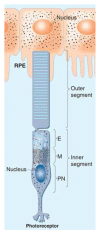Autophagy in light-induced retinal damage
- PMID: 26325327
- PMCID: PMC4698080
- DOI: 10.1016/j.exer.2015.08.021
Autophagy in light-induced retinal damage
Abstract
Vision is reliant upon converting photon signals to electrical information which is interpreted by the brain and therefore allowing us to receive information about our surroundings. However, when exposed to excessive light, photoreceptors and other types of cells in the retina can undergo light-induced cell death, termed light-induced retinal damage. In this review, we summarize our current knowledge regarding molecular events in the retina after excessive light exposure and mechanisms of light-induced retinal damage. We also introduce works which investigate potential roles of autophagy, an essential cellular mechanism required for maintaining homeostasis under stress conditions, in the illuminated retina and animal models of light-induced retinal damage.
Keywords: ATG7; All-trans-retinal; Beclin1; Light-induced retinal damage; Park2; Visual cycle.
Copyright © 2015 Elsevier Ltd. All rights reserved.
Figures




Similar articles
-
Rhodopsin-mediated blue-light damage to the rat retina: effect of photoreversal of bleaching.Invest Ophthalmol Vis Sci. 2001 Feb;42(2):497-505. Invest Ophthalmol Vis Sci. 2001. PMID: 11157889
-
Exposure to a solar eclipse causes neuronal death in the retina.Graefes Arch Clin Exp Ophthalmol. 2001 Oct;239(10):794-800. doi: 10.1007/s004170100362. Graefes Arch Clin Exp Ophthalmol. 2001. PMID: 11760043
-
Hyperthermia accelerates retinal light damage in rats.Invest Ophthalmol Vis Sci. 1995 May;36(6):997-1008. Invest Ophthalmol Vis Sci. 1995. PMID: 7730034
-
Retinal light damage: From mechanisms to protective strategies.Surv Ophthalmol. 2024 Nov-Dec;69(6):905-915. doi: 10.1016/j.survophthal.2024.07.004. Epub 2024 Jul 23. Surv Ophthalmol. 2024. PMID: 39053594 Review.
-
A comprehensive review of experimental models for investigating blue light-induced ocular damage: Insights into parameters, limitations, and new opportunities.Exp Eye Res. 2024 Dec;249:110142. doi: 10.1016/j.exer.2024.110142. Epub 2024 Oct 28. Exp Eye Res. 2024. PMID: 39490726 Review.
Cited by
-
Xanthohumol Protects Morphology and Function in a Mouse Model of Retinal Degeneration.Invest Ophthalmol Vis Sci. 2018 Jan 1;59(1):45-53. doi: 10.1167/iovs.17-22132. Invest Ophthalmol Vis Sci. 2018. PMID: 29305606 Free PMC article.
-
α-Synuclein impairs ferritinophagy in the retinal pigment epithelium: Implications for retinal iron dyshomeostasis in Parkinson's disease.Sci Rep. 2017 Oct 9;7(1):12843. doi: 10.1038/s41598-017-12862-x. Sci Rep. 2017. PMID: 28993630 Free PMC article.
-
NDRG2 suppression as a molecular hallmark of photoreceptor-specific cell death in the mouse retina.Cell Death Discov. 2018 Sep 12;4:32. doi: 10.1038/s41420-018-0101-2. eCollection 2018. Cell Death Discov. 2018. PMID: 30245855 Free PMC article.
-
Plasma Rich in Growth Factors Promotes Autophagy in ARPE19 Cells in Response to Oxidative Stress Induced by Blue Light.Biomolecules. 2021 Jun 28;11(7):954. doi: 10.3390/biom11070954. Biomolecules. 2021. PMID: 34203504 Free PMC article.
-
Potential protective function of the sterol regulatory element binding factor 1-fatty acid desaturase 1/2 axis in early-stage age-related macular degeneration.Heliyon. 2017 Mar 16;3(3):e00266. doi: 10.1016/j.heliyon.2017.e00266. eCollection 2017 Mar. Heliyon. 2017. PMID: 28367511 Free PMC article.
References
-
- Aita VM, Liang XH, Murty VVVS, Pincus DL, Yu W, Cayanis E, Kalachikov S, Gilliam TC, Levine B. Cloning and Genomic Organization of Beclin 1, a Candidate Tumor Suppressor Gene on Chromosome 17q21. Genomics. 1999;59:59–65. - PubMed
-
- Alloway PG, Howard L, Dolph PJ. The formation of stable rhodopsin-arrestin complexes induces apoptosis and photoreceptor cell degeneration. Neuron. 2000;28:129–138. - PubMed
-
- Arshavsky VY, Lamb TD, Pugh EN., Jr. G proteins and phototransduction. Annual review of physiology. 2002;64:153–187. - PubMed
-
- Bilen J, Bonini NM. Drosophila as a model for human neurodegenerative disease. Annual review of genetics. 2005;39:153–171. - PubMed
Publication types
MeSH terms
Grants and funding
LinkOut - more resources
Full Text Sources
Other Literature Sources
Medical

